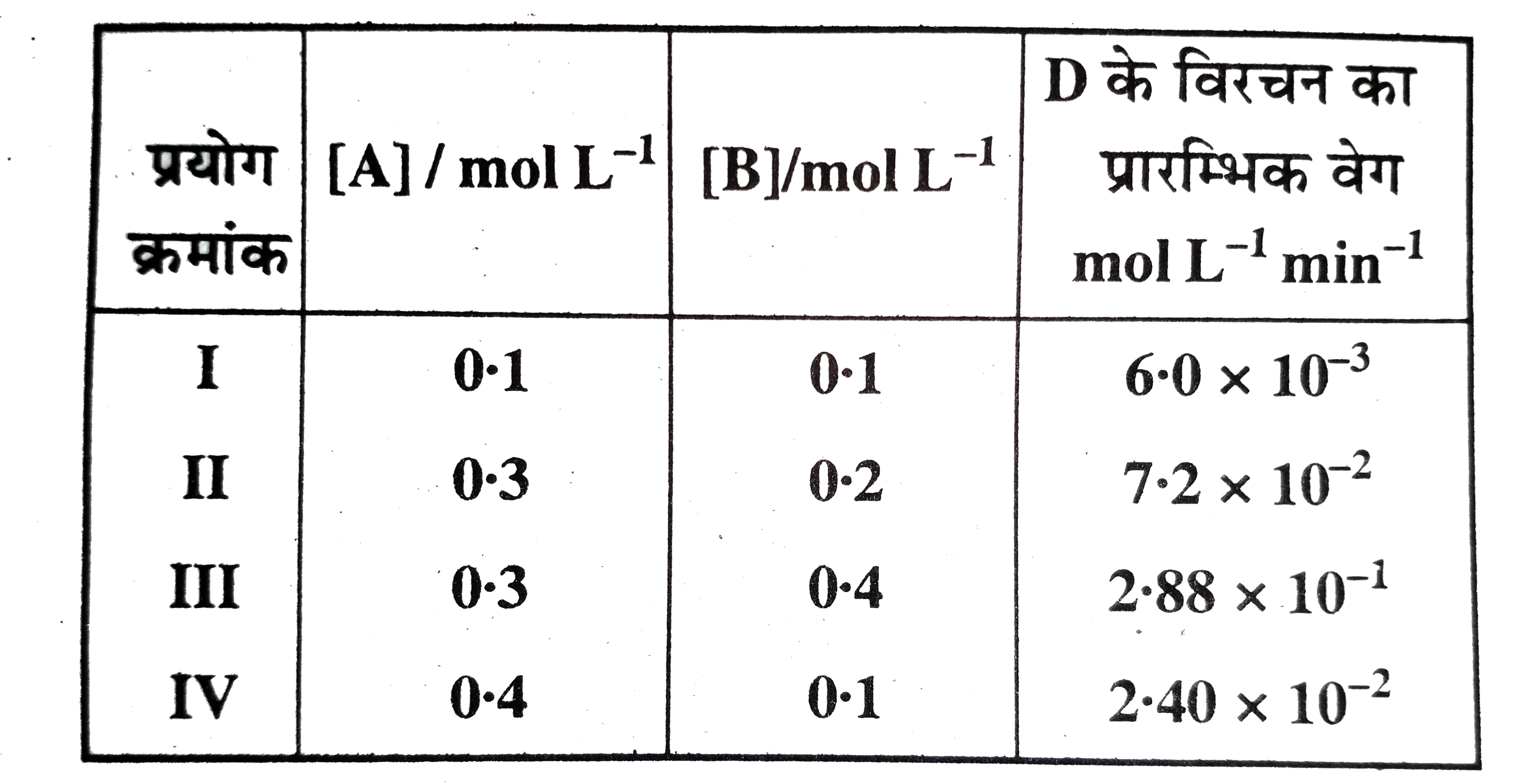The following results have been obtained during the kinetic studies of the reaction :
2A+B→C+D

Determine the rate law and rate constant for the reaction. Solution in Telugu
Rate law may be expresswed as
Rate =k[A]x[B]y
[Rate]1=6.0×10−3=k(0.1)x(0.1)y−(i)
[Rate]2=7.2×10−2=k(0.3)x(0.2)y−(ii)
[Rate]3=2.88×10−1=k(0.3)x(0.4)y−(iii)
[Rate]4=2.40×10−2=k(0.4)x(0.1)y−(iv)
(Rate)1(Rate)4=6.0×10−32.40×10−2=k[0.1]x[0.1]yk[0.4]x[0.1]yor14=(0.1)y(0.4)x=(14)xx=1
(Rate)2(Rate)3=7.2×10−22.88×10−1=k[0.3]x[0.2]yk[0.3]x[0.4]yor14=(0.2)y(0.4)y=[12]yy=2
∴ Rate law expression is given by Rate =k[A][B]2
Rate constant k, can be determined by placing the values of A, B and rate of formation of D. By taking the values for experiment II.
Rate k[A][B]2
k=Rate[A][B]2=7.2×10−2molL−1min−1(0.3molL−1)(0.2molL−1)2=6.0mol−2L2min−1
∴k=6.0mol−2L2−1min.
Topper's Solved these Questions
- BOOK - VIKRAM PUBLICATION ( ANDHRA PUBLICATION)CHAPTER - ELECTROCHEMISTRY & CHEMICAL KINETICSEXERCISE - VERY SHORT ANSWER QUESTIONS63videos
ELECTROCHEMISTRY & CHEMICAL KINETICS
- BOOK - VIKRAM PUBLICATION ( ANDHRA PUBLICATION)CHAPTER - ELECTROCHEMISTRY & CHEMICAL KINETICSEXERCISE - SHORT ANSWER QUESTIONS25videos
ELECTROCHEMISTRY & CHEMICAL KINETICS
- BOOK - VIKRAM PUBLICATION ( ANDHRA PUBLICATION)CHAPTER - ELECTROCHEMISTRY & CHEMICAL KINETICSEXERCISE - DAM SURE18videos
ELECTROCHEMISTRY & CHEMICAL KINETICS
- BOOK - VIKRAM PUBLICATION ( ANDHRA PUBLICATION)CHAPTER - D AND F- BLOCK ELEMENTS AND CO-ORDINATION COMPOUNDS EXERCISE - INTEXT QUESTIONS33videos
D AND F- BLOCK ELEMENTS AND CO-ORDINATION COMPOUNDS
- BOOK - VIKRAM PUBLICATION ( ANDHRA PUBLICATION)CHAPTER - GENERAL PRINCIPLES OF MMETALLURGYEXERCISE - DAM SURE SAQ1videos
GENERAL PRINCIPLES OF MMETALLURGY
Similar Questions
What is a galvanic cell or a valtaic cell ? Give one example.
View SolutionWhat are galvanic cells ? Explain the woriking of a galvanic cell with a neat sketch taking Denicell cell as example.
View SolutionDiffine conductivity of a material. Give its SI units.
View SolutionSilver atom has completely filled d-orbitals (4d10) in its ground state. How can you say that it is a transition element ?
View SolutionGive examples to differentiate roasting and calcination.
03:03View SolutionDuring the kinetic study of the reaction, 2A+B→C+D. Following results were obtained.

Based on the above data which one of the following is correct?09:08View SolutionThe following rate data were obtained at 303 K for the following reaction:
2A+B→C+D

What is the rate law? What is the order with respect to each rectant and the overall order? What are the units of the rate constant?09:08View SolutionConsider the reaction 2A + B to C + D Following results was obtained in experiments designed to study the rate of reaction" a) Write the rate law for the reaction b) Calculate the value of rate constant for the reactio. c) Which of the following possible reaction mechanisms is consistent with the rate law found in (a) ? I. A + B to C + E (slow) A + E to D (fast) IIgt B to C+E (slow) A + E to F (fast) A + F to D (fast)
03:50View SolutionThe following initial rate data were obtained at 300K for the reactions: 2A + B to C +D Deducethe rate law.
06:37View SolutionDuring the kinetic study of the reaction, 2A+BtoC+D , following results were obtained Order of the reaction is
09:08View Solutionकिसी अभिक्रिया कि बलगतिकी के अध्ययन से निम्न परिणाम प्राप्त हुए-

अभिक्रिया के लिए वेग नियम तथा सिथरांक ज्ञात कीजिये।06:32View Solution2A+B→C+D अभिक्रिया की बलगतिकी अध्ययन करने पर निम्नलिखित परिणाम प्राप्त हुए। अभिक्रिया के लिए वेग नियम तथा वेग स्थिरांक ज्ञात कीजिए।
 07:59View Solution
07:59View SolutionThe following results have been obtained during the kinetic studies of reaction : The rate law is
06:18View SolutionDuring the kinetic study of the reaction, 2A+Brarr C+D , following results were obtained Based on the above data which one of the following is correct?
04:50View Solution2A+B→C+Dअतः अभिक्रिया की बगलतिकी अध्यन करने पर निम्नलिखित परिणाम प्राप्त हुए। अभिक्रिया के लिए नियम तथा वेग । स्थिरांकज्ञात कीजिए।
 06:52View Solution
06:52View SolutionThe following results have been obtained during the kinetic studies of the reaction:
P+2Q→R+2S

Determine the rate law expression for the reaction.04:02View Solution

